
"The enemy's fire was effective from the onset but the heaviest casualties occurred on passing through the gaps in our front wire where the men were mown down in heaps. In spite of losses, the survivors steadily advanced until close to the enemies wire by which time few remained."
- Diary of the 1st Newfoundland Regiment, July 1st, 1916
















































